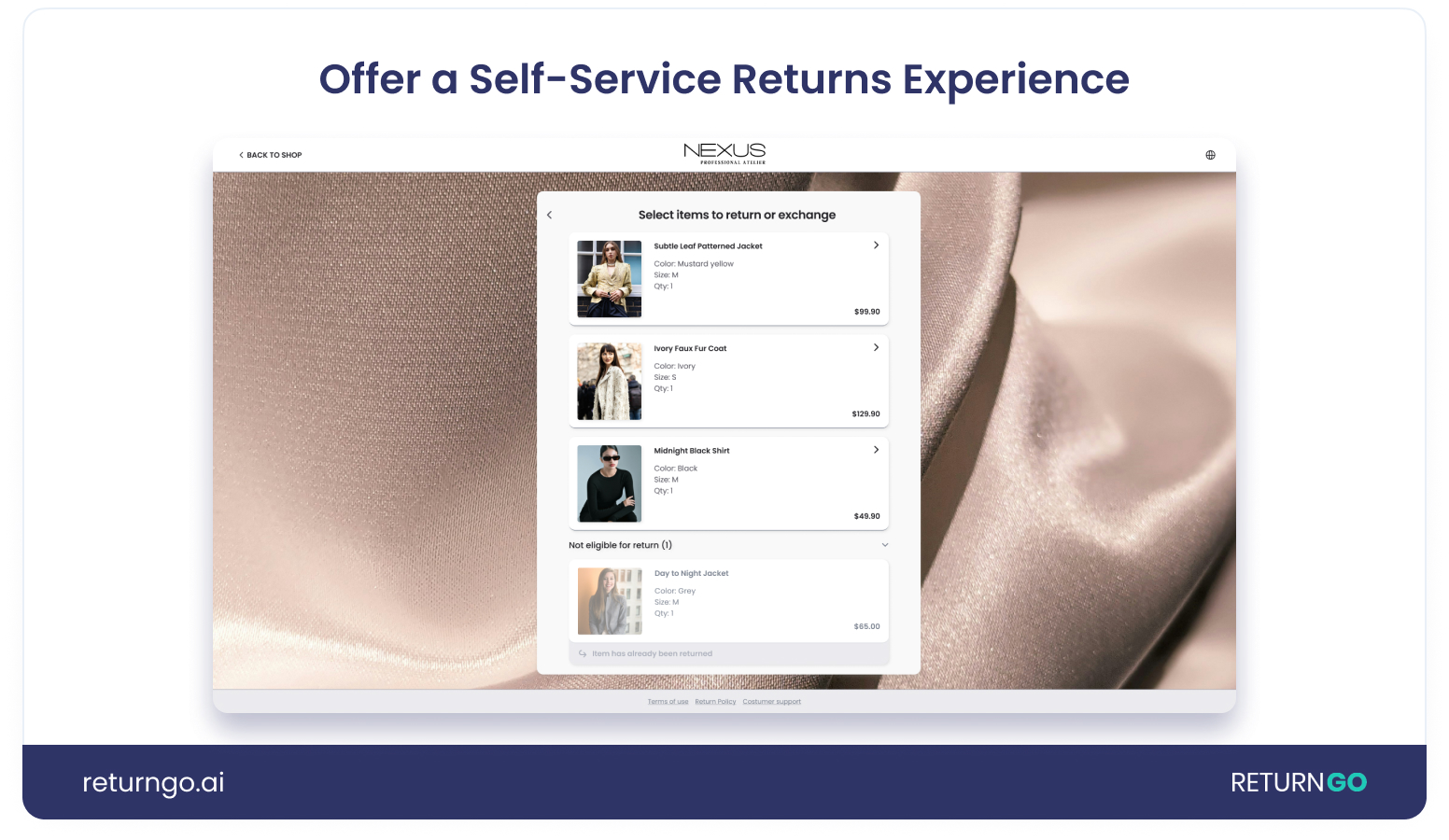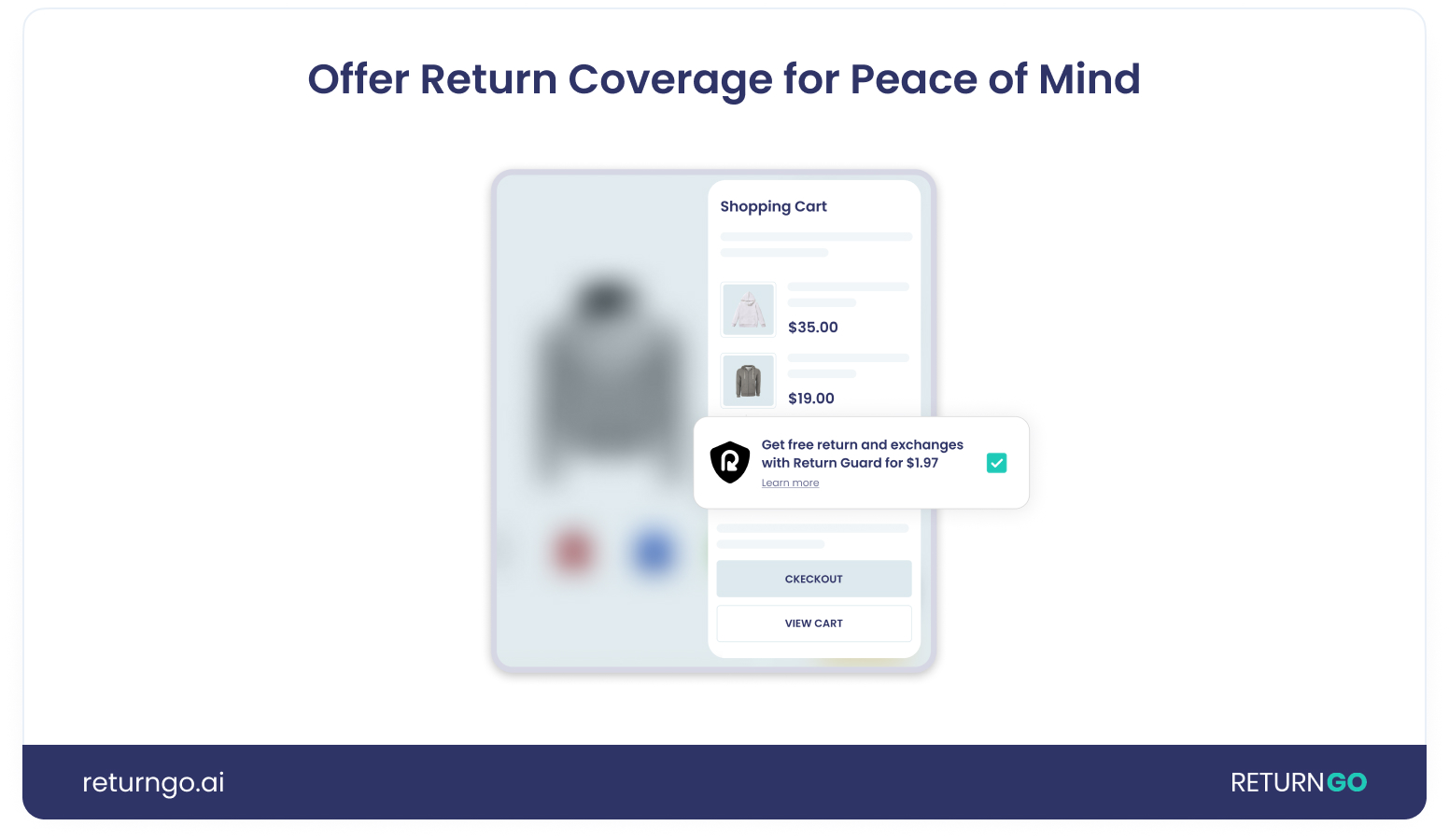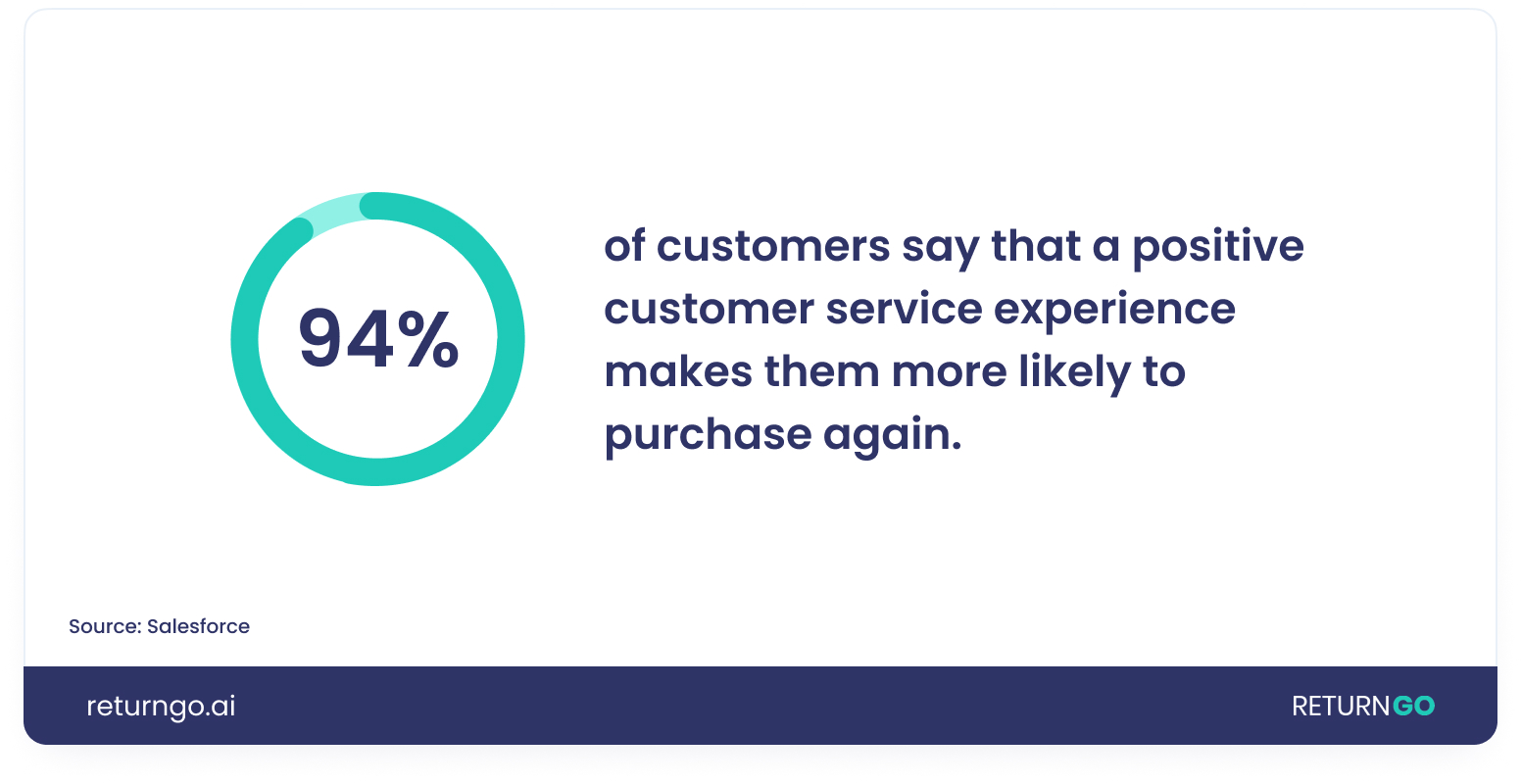5 Proven Tactics to Turn Your Returns Process Into a Competitive Advantage on Shopify
Rebecca Lazar
Achieving a competitive edge through your returns process means going beyond just offering free returns. It requires strategically designing every single touchpoint a customer might have related to a potential return, starting even before they place their order.
A hassle-free, customer-centric returns experience can build strong trust and create loyal customers.

5 Tactics to Make Returns a Competitive Advantage
In order to turn your Shopify returns process into a competitive edge, there are a few tactics you can use:
1. Prevent Returns Before They Happen
The most cost-effective return is the one that never occurs. By preventing returns upfront, you save direct costs associated with processing returns while also preserving valuable revenue and, most importantly, leading to happier, more satisfied customers.
Leverage AI for Smarter Product Recommendations
Use AI tools that analyze customer behavior like browsing habits, purchase history, and product pairings to recommend items they’re more likely to keep. AI-powered support agents, such as Juphy, can even make real-time, personalized recommendations in chat.
Helping customers choose the right item the first time greatly reduces returns from issues like sizing or mismatched expectations.
Enhance Product Detail Pages
Your product page should be your best virtual salesperson. Go beyond the basics with multiple high-resolution images, product videos, detailed size charts, clear material breakdowns, and real customer reviews. These elements can help set accurate, realistic expectations, which is key to avoiding unnecessary returns.
Reduce Friction in Customer Service
When customers are uncertain about what to buy or how to buy it, they’re more likely to end up returning the item later on. You can minimize customer post-purchase regret by reducing friction in the buying process.
AI chatbots, trained on your product info and FAQs, can resolve common questions 24/7 about size, fit, material, or compatibility. Eliminating guesswork at the point of purchase helps prevent returns afterward.
2. Empower Customers with Self-Service Returns
When returns are necessary, the goal should be to make the process absolutely effortless for the customer while simultaneously making it highly efficient for your internal team.
Implement a Branded, Automated Returns Portal
It’s time to ditch the cumbersome email back-and-forth for return requests. Set up a dedicated online returns portal directly accessible from your Shopify store. This portal should allow customers to initiate returns 24/7 using just their order number and email address.
Self-service options are highly valued by today’s consumers, with 81% of customers saying they want more self-service options (NICE).
Crucially, ensure this portal perfectly matches your store’s branding (logo, colors, fonts) to provide a cohesive, professional, and trustworthy experience. Platforms like ReturnGO integrate seamlessly with Shopify, offering exactly this – a customizable, self-service return portal that intuitively guides customers step-by-step through initiating their return.
Automate Return Labels and Tracking
Configure your returns system to automatically generate pre-paid shipping labels or convenient QR codes (for printerless returns) as soon as a return request is submitted and meets your predefined policy criteria.
It’s also important to provide customers with tracking updates for their return shipment, accessible directly in the portal or sent via automated email updates. This level of automation drastically reduces manual workload for your support team and proactively minimizes those repetitive “Where is my refund?” or “Where is my label?” support queries.
Clearly Display Applicable Policies In-Flow
Don’t force customers to hunt through website footers or separate FAQ pages to understand your return policy.
Clearly explain the relevant rules such as the allowed return window, item eligibility criteria, available resolution options (refund, exchange, store credit etc), and any potential restocking fees directly within the self-service portal at the moment they are initiating the return. This upfront transparency builds trust and prevents misunderstandings later in the process.

3. Optimize Return Options & Policies
Your returns process represents a critical juncture for revenue retention. Instead of defaulting solely to cash refunds, strategically guide customers towards options that keep their spending value within your business ecosystem.
Actively Prioritize and Incentivize Exchanges
Make exchanging an item the easiest, fastest, and most attractive option available. Offer appealing features like “instant exchanges,” where the replacement item ships as soon as the returning item receives its first carrier scan, minimizing wait times.
Consider providing a small bonus store credit (e.g., “$5 extra credit”) specifically for choosing an exchange or store credit over a cash refund. Utilize smart suggestions within the returns flow – features readily available in tools like ReturnGO – to automatically recommend alternative sizes, colors, or even different but related products based on the initial purchase and return reason.
Provide Store Credit as a Flexible Alternative
Position store credit prominently as a primary return outcome. This simple tactic keeps the customer’s money within your store, effectively turning a potential lost sale into a guaranteed future purchase. You can further increase its appeal by highlighting store credit as a faster resolution method compared to waiting for a bank refund to process.
Offer Optional Return Coverage
Explore innovative policy models to give customers more choice and peace of mind. For instance, offer customers the option to purchase low-cost “return assurance” or “premium return coverage” during the initial checkout. This small, non-refundable fee could grant them enhanced benefits like free return shipping on all orders, waived restocking fees, or an extended return window.
This approach provides customers with valuable peace of mind while simultaneously helping your business offset the inherent costs associated with processing returns.

4. Turn Returns Data into Actionable Improvements
Every single return contains a nugget of valuable information about your products, your marketing, or your customer experience. Instead of seeing returns as just a cost line item, treat them as a crucial source of business insight that can fuel growth.
Systematically Track Key Return Metrics
Utilize your returns management platform to monitor key return metrics. Track categorized return reasons (encourage specific reasons beyond generic ones), return rates per specific SKU or product variant, exchange rates versus refund rates, the average cycle time to process a return from initiation to resolution, and any qualitative customer feedback submitted during the returns process.
Identify Patterns and Root Causes
Don’t just collect data; analyze it regularly. Dive deep to identify recurring patterns. Is one particular shirt consistently returned for “running small”? Does a specific electronic gadget frequently get returned as “not matching the online description”? Are returns for fragile items spiking, potentially indicating packaging issues?
Look for trends over time, across different product categories, and even correlate them with marketing campaigns.
Implement Concrete Changes Based on Insights
This is where data transforms into powerful action. Translate your findings into tangible improvements.
Consistently high “wrong size” returns for an item? Improve its size chart, add model fit videos, or even adjust the product’s manufacturing specs. Frequent “not as described” returns? Rewrite the product description for clarity, add more detailed photos, or perform a quality control check on inventory.
Use this continuous feedback loop to drive improvements across product development, merchandising strategy, website presentation, and marketing accuracy.
5. Provide Personalized Post-Purchase Support
The quality of communication and support during the returns process significantly influences a customer’s overall perception of your brand. Aim to make this experience smooth, proactive, intelligent, and reassuring.
Automate Proactive Status Communication
Keep customers informed every step of the way, without them needing to reach out and ask. Ensure your systems automatically send email and/or SMS updates at key milestones in the order tracking process. This level of transparency reduces customer anxiety and proactively prevents many routine support inquiries.
Deploy AI for Instant Answers & Support
This is where intelligent support automation, like Juphy’s AI Agent, truly becomes a game-changer for efficiency and customer satisfaction.
Train an AI chatbot specifically on your return policies, standard procedures, and common customer questions. It can then instantly handle a high volume of repetitive queries 24/7 – questions like “Where is my refund?”, “How do I start a return?”, or “What’s your holiday return policy?”. This drastically reduces customer wait times and frees up your valuable human support team to focus on more complex, nuanced issues.
Personalize Follow-Up
Move away from generic, one-size-fits-all communication after a return is completed. Use the specific return outcome and the customer’s purchase history to tailor your follow-up messages.
For a customer who successfully exchanged an item, send a quick, personalized check-in message a week later to ensure they’re happy with the new product. For a high-value customer who received a refund, consider sending a personalized “we miss you” offer or a curated recommendation to encourage their next purchase.
94% of customers say that a positive customer service experience makes them more likely to purchase again (Salesforce), so providing personalized post-purchase support can have a huge impact on customer loyalty.

Make Returns Your Shopify Superpower
Returns represent a critical opportunity to impress customers and build lasting loyalty, rather than simply being a drain on your resources and time.
By actively implementing these five tactics, you can effectively shift returns from a perceived liability to a powerful strategic asset.
The key to success lies in adopting a relentlessly customer-centric approach, powered by the right technology stack. Combining an efficient, data-rich returns management system (like ReturnGO) with intelligent, automated customer support (like Juphy) creates a potent synergy that elevates the entire post-purchase experience, turning potentially negative situations into positive brand interactions.
Start implementing these actionable strategies today and turn your returns process into a true competitive superpower.
Key Takeaways
- Prevent First: Use AI recommendations (like Juphy can provide) and rich product details to help customers choose correctly initially, reducing return likelihood.
- Empower Customers: Offer a seamless, branded self-service portal (using tools like ReturnGO) for easy 24/7 return initiation and tracking.
- Optimize Outcomes: Actively prioritize and incentivize exchanges and store credit over simple refunds to retain revenue.
- Learn Continuously: Treat returns data as invaluable feedback to improve products, marketing, and processes.
- Support Intelligently: Deploy AI for instant answers to common return questions, proactive communication, smarter interactions, and seamless escalation to human agents when needed.
- Integrate Tools: Combine specialized returns management platforms with AI support tools for a comprehensive, efficient, and customer-centric post-purchase strategy that builds loyalty.

